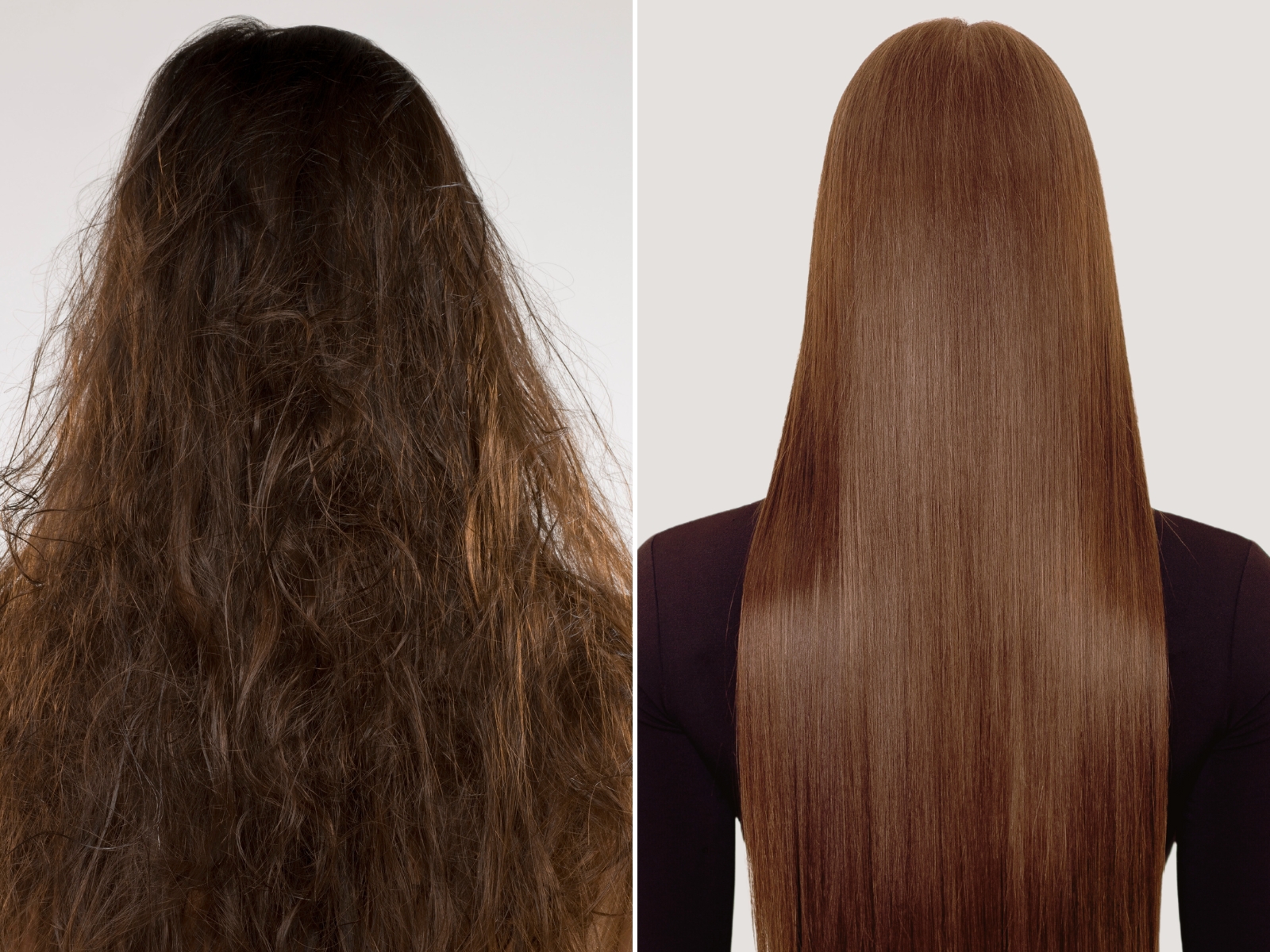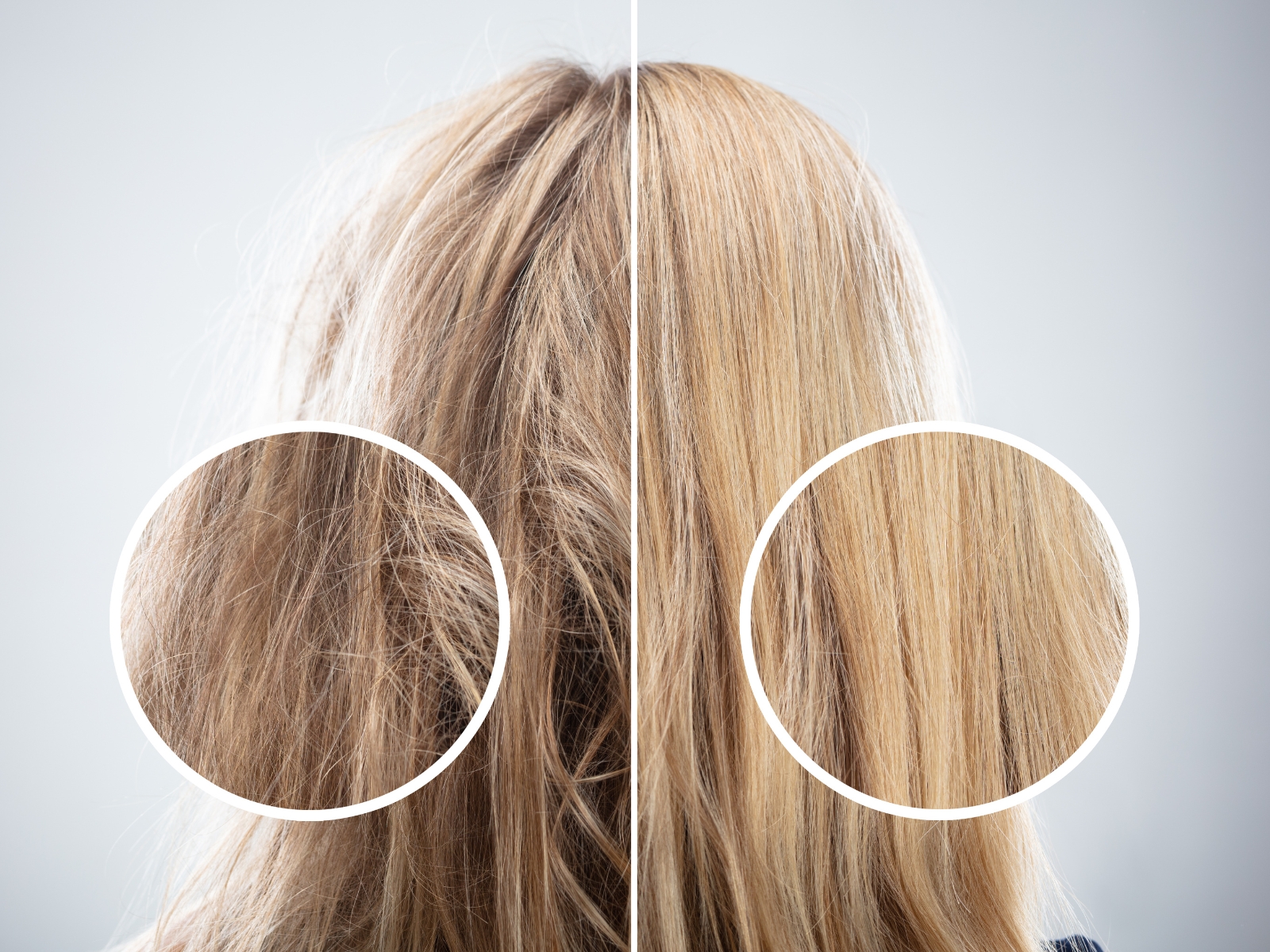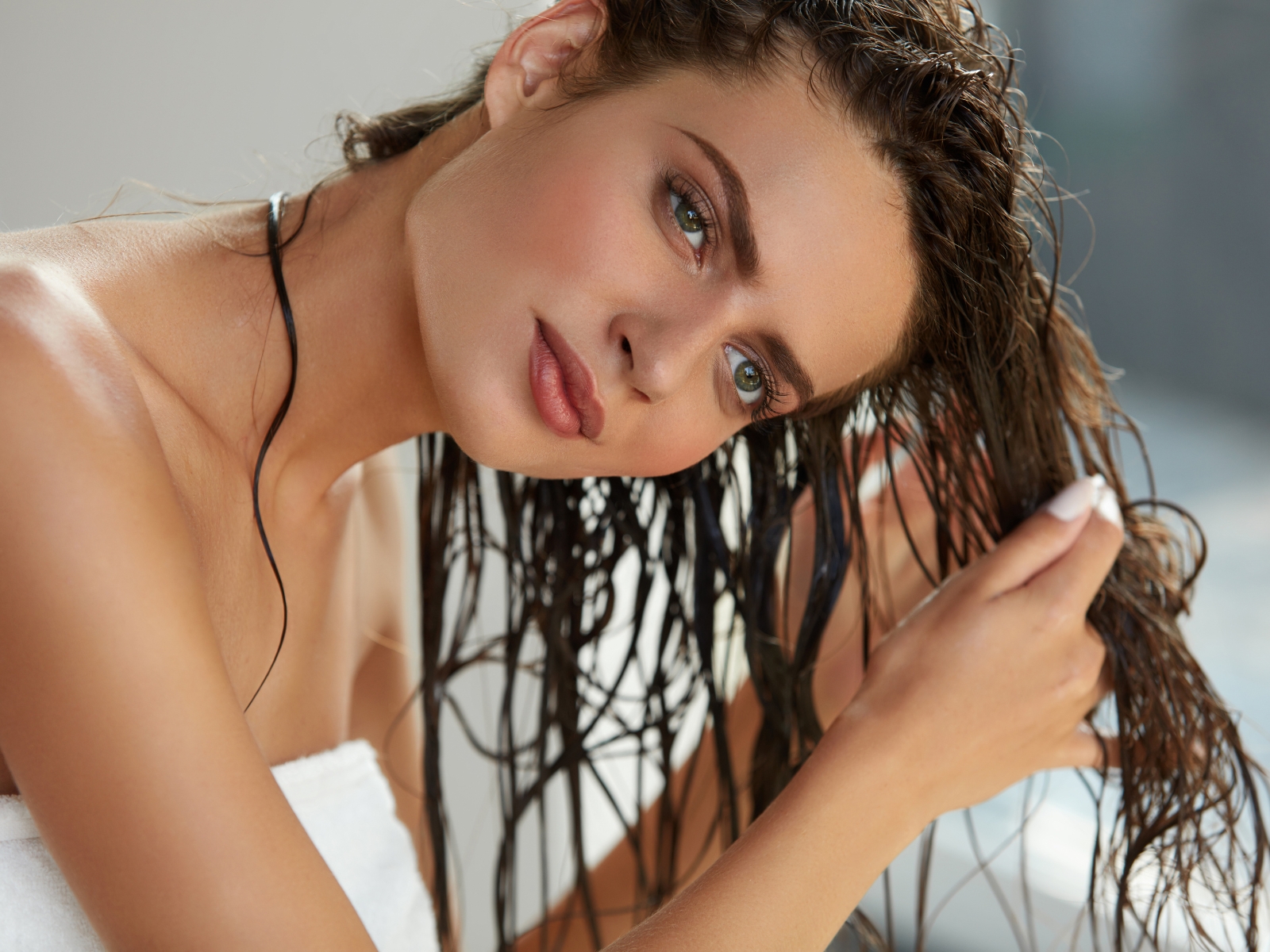You know the story: you get a blowout, and you’re really feeling your silky hair, then it rains—and it’s frizzy all over. Or you follow all the steps supposed to give you sleek, defined curls, but humid weather and halo frizz spoil your fun.
Follow this guide to find out the solution to your struggles and learn how to get the smoothest strands and bounciest, frizz-free curls.
What Is Frizz?
Each hair strand has a protective outer layer called the cuticle. In healthy hair, the cuticle resembles fish scales lying smoothly along the strand.
Related: -7 Straight-Hair Problems No One Talks About And 8 Easy Fixes That Shine
When the hair is dry or damaged, the hair shaft soaks up moisture from the air which causes it to swell. This raises the cuticle, and the strand is no longer smooth, but instead rough and frizzy.
So clearly, the key to frizz-free hair is keeping the cuticles flat and sealed. Read on to learn how.
Types Of Frizzy Hair
There are two kinds of frizzy hair: frizzy hair caused by hair structure and frizzy hair caused by damage.
Some amount of frizz is normal and can give the hair volume and a charming, laid-back look. Hair strands are naturally porous, especially in wavy and curly hair, which absorbs more moisture. Those hair types might be frizzy even when they’re not damaged and require more hydration to stay smooth.
Frizz caused by damage, on the other hand, can be difficult to tame, but it can be prevented with the right hair care, products and habits.
What Causes Frizzy Hair?
Whatever your hair type, frizz can happen. Here’s what tends to cause it.
1. Dryness
Frizz happens when the hair strands absorb moisture from the environment, so dehydration is the primary cause of frizzy hair. Some hair types are more naturally dry—curly and wavy hair are both prone to dryness.
The curlier the hair, the more quickly it loses moisture, so coily hair requires the most hydration. It’s also the most fragile hair type and needs to be handled with the most amount of care.
Lots of people with wavy hair aren’t even aware of their hair texture, but actually think it’s just straight hair that’s frizzy and needs to be smoothed. Once wavy hair is properly moisturized, its real, gorgeous texture shows.
2. Damage
Hair damaged by heat styling, processing or coloring has open cuticles which makes it more vulnerable and porous, which allows moisture to enter the hair shaft and makes it difficult for product to be absorbed. This is why over-processed hair can’t hold onto moisture, so it’s frizzy and won’t stay smooth even when you take care of it.
3. Styling technique
The way you style your hair has a huge impact on frizz. It can be caused by habits such as:
- Overwashing your hair. Washing your hair every day can strip the scalp of its natural oils and cause dryness.
- Washing your hair using hot water. Very hot water makes your hair more porous, creating frizz.
- Towel-drying your hair. Terry cloth towels are harsh and remove too much moisture from hair.
- Friction. If you’re brushing your hair too much, you risk damaging it. Brushing curly hair lifts the cuticle, directly leading to frizz.
- Drying mistakes. Using a hair dryer without a nozzle or using it incorrectly causes frizz. If your hair is curly, touching it as it air dries also disrupts the curl pattern.
4. Products
Products can cause frizz in several ways:
- Using the wrong products.
- Product buildup.
- Applying products incorrectly.
- Using harsh hair products.
- Not using products at all.
5. Weather
Humidity is the reason your hair gets frizzy when it rains or in the summer: dehydrated hair absorbs moisture from the environment, the hair shaft swells and the cuticle lifts. This causes frizz and even more dryness.
How To Manage Frizzy Hair?
Gradually incorporating these easy habits into every step of your routine will make your hair smooth and frizz-free.
Washing
- Don’t wash your hair every day.
- Use lukewarm water for washing your hair, finishing with a cold rinse to seal the cuticles.
- To minimize friction and breakage, never use terry cloth towels to dry your hair. Instead, use a microfiber towel or an old cotton t-shirt.
- Don’t rub your hair with the towel, but gently blot out the water.
Products
- Use a hydrating cleanser—look for products marked as moisturizing and anti-frizz. Opt for a shampoo that is sulfate-free and contains glycerin.
- Use leave-in conditioner as the first step after you step out of the shower. You can follow up with hair cream for extra moisture, especially if your hair is curly or wavy.
- Apply product on wet hair in sections, making sure to cover each strand.
- Apply a serum or hair oil to damp hair, then also as finish to lay down any remaining frizz when your hair is dry.
- Deep-condition your hair once a week, using commercial masks or home-made treatments.
- If your hair is curly or wavy, apply product only on soaking wet hair and distribute it using a wide-toothed comb, detangling brush or your fingers.
- When your hair starts to feel weighed down, use a clarifying shampoo to get rid of buildup.
Styling
- Lower the heat when your hair is almost dry and finish with cool air to seal the cuticle.
- If you blow-dry your hair, consider using a boar-bristle brush. They evenly distribute the scalp’s oils over the hair, which helps minimize frizz and prevents damage.
- Blow-dry your hair in sections instead of everything at once.
- Don’t flip your hair upside down, but always direct air downward to smooth the cuticle.
- When straightening your hair, use the nozzle attachment to direct air flow.
- Don’t use any hot tools without preparing your hair with heat protectant.
- Make sure you dry your hair completely when blow-drying—you’ll know you’re done when there’s no more tension as you’re running the brush through.
- For a natural finish that’s frizz-free use a diffuser attachment.
- If your hair is curly and you want defined curls, diffuse to speed up drying and get more volume. Keep the diffuser at the distance and avoid touching your curls except to gently scrunch them.
- Use other heat tools such as the curling iron or a straightener sparingly.
Maintenance
- Get regular trims to prevent split ends and damage which causes frizz.
- If you live in a humid environment, protect your hair from humidity and heat with an anti-humidity spray or a frizz-protectant that provides a barrier against moisture.
- Switch to a silk or satin pillowcase—these materials don’t absorb moisture so your hair will be smoother and less prone to tangles.
- Accept that some frizz is normal and focus on caring for your hair instead of fighting your texture.
Frequently Asked Questions
1. Is frizzy hair unhealthy hair?
Unhealthy hair is often frizzy, but not all frizzy hair is unhealthy. Some hair types, like wavy and curly, are naturally frizzy even when healthy and require more moisture to be smooth.
2. What is the main cause of frizzy hair?
Dryness is the main issue when it comes to frizz. Dry hair absorbs moisture from the air, making the cuticle lift, which results in frizzy hair.
3. How do I stop my hair from frizzing?
Keep your hair from becoming frizzy by keeping it hydrated and damage-free.
4. What to use for frizz?
Some of the products often used to manage frizzy hair are sulfate-free shampoo, deep conditioning mask, leave-in conditioner, hair oil, hair cream, serum, anti-frizz spray and heat-protectant. Experiment to find your ideal combination.
5. Should I brush my curly hair?
Only brush curly hair when it’s wet, as you’re applying leave-in conditioner or other products. Use a detangling brush.
Key Takeaways
- It’s all about moisture! Keep your hair hydrated to stay frizz-free.
- Wavy and curly hair are naturally more prone to frizz, as is damaged hair.
- Use moisturizing products and products that protect your hair.
- Be gentle with your hair and avoid habits that can damage it.







